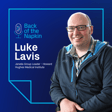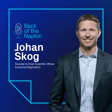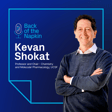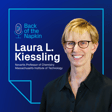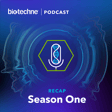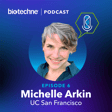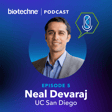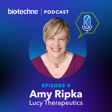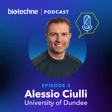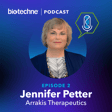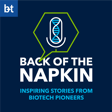Become a Creator today!Start creating today - Share your story with the world!
Start for free
00:00:00
00:00:01

Matt Disney: Drugging RNA – Pioneering a New Field in Drug Discovery
Matthew Disney is a Professor and Chair at the University of Florida Scripps Institute. In this podcast he discusses the origins of a new field he has pioneered – ‘Drugging RNAs with small molecules’. The conversation covers the eureka moments, the challenges, RIBOTACs, and the opportunities that lie ahead.
Disney Lab Website: https://disney.scripps.ufl.edu/
Matt’s Twitter: https://twitter.com/disney_lab?lang=en
Transcript
Origins of Discoveries
00:00:03
Speaker
A discovery is said to be an accident meeting a prepared mind, but every story behind a discovery is different.
00:00:11
Speaker
Perhaps the idea is conceived in a light-bulb moment, or a brainstorming session, or captured in scribblings on the back of a napkin.
Innovation Corner Introduction
00:00:19
Speaker
Here, we introduce you to scientific pioneers, taking you beyond their publication and into Innovation Corner to hear the untold stories behind their discoveries. This podcast is brought to you by Biotech, and I'm your host, Alex Maloney.
Advancements in RNA Drug Mechanisms
00:00:38
Speaker
Until recently, the textbook answer to how drugs work would likely describe drug-like compounds binding to a protein target and affecting the function that implicates that protein in a disease. Now, you should expect to see not just proteins, but RNA in that description. Thanks to the work of our guest today, Professor Matthew Disney.
00:01:00
Speaker
Matt is based at the University of Florida Scripps Institute and has dedicated his career to demonstrating RNA can be targeted by small molecules, laying some solid foundations for others to adopt this concept. Diseases and protein targets have been considered
00:01:17
Speaker
quote unquote undrugable have now had a spotlight on unstructured RNA targets with pockets capable of selectively binding small molecules. Matt has published on such RNA targets for diseases including Alzheimer's, ALS, Huntington's, Parkinson's and muscular dystrophies among others.
00:01:37
Speaker
And what if binding alone doesn't lead to the desired output, as can often be the case. Walmart's thought up a solution to that one too, and it's called the Ribotack.
Ribotack Technology Explored
00:01:48
Speaker
This is a hetero bifunctional compound, but one end binds the target RNA, and the other end recruits a Nuclease to degrade the RNA. You're going to be hearing a lot more about this technology in the next few years, as others are jumping on the bandwagon.
Career Highlights and Challenges of Matt Disney
00:02:04
Speaker
In this podcast, Matt gives an incredibly honest insight into the conflictions and challenges he's faced during his career. This is a story filled with eureka moments, perseverance and above all else, Matt's overarching goal to do good in the world.
00:02:21
Speaker
Talking to Matt, it still feels like this is just the beginning. And only now are we at the part where real human lives will benefit from his discoveries.
Podcast Introduction: 'Back of the Napkin'
00:02:30
Speaker
I hope you enjoy this podcast. So without any further ado, welcome to back of the napkin. Matt Disney. Hi, welcome to the podcast.
Matt Disney's Journey into RNA Studies
00:02:43
Speaker
Hi, Alex. Thank you. I have been super excited to have you on this show. You have been the headline actor, a lot of the
00:02:51
Speaker
RNA conferences that I have been attending recently, so it's a real pleasure to have you here today. Okay, so this is a podcast where we introduce the listeners to scientific pioneers. So as with all good stories, we'll start from the beginning. How did you get into science? Yeah, I'm from a pretty large family. I have six brothers and sisters. I grew up
00:03:18
Speaker
in Baltimore, which is my favorite place on Earth. Don't judge me based on that. It's just where I'm from. And I was always interested in working hard. That was, I think, the biggest example from my dad. My dad worked very hard for the family. And I was always interested in science. So I remember when I was a young kid,
00:03:49
Speaker
You know, I got a telescope. Being from Baltimore, my favorite celestial object was the Crab Nebula. Baltimore is very famous for blue crabs that come from the Chesapeake Bay. And so I used to, you know, look in the stars and wonder what those things are made of. I thought it was remarkable that if an object is, you know, three billion light years away, the light that's touching our eyes is three billion years old.
00:04:18
Speaker
And so that always sort of my desire to want to understand things, to learn about science. And I think the example from my dad drew me to wanting to do
Influences on Matt's Scientific Path
00:04:35
Speaker
science. You know, not surprisingly, given that I'm from Baltimore and from a large family, I grew up very Catholic. And so there was always,
00:04:45
Speaker
you know, you're told that when you grow up in that environment, you have to find your vocation, right? What you were, you know, on this earth to do. And I found that, that in terms of other than being a husband and a dad is
00:05:02
Speaker
doing science. So I think in some sense, it was a thing that I was naturally drawn to for all of those reasons. So six brothers and sisters, wow. So there must have been some competition there, right? Interesting. So there's a gap of six years, seven years between me and my older brother, and then three years with me and my younger brother.
00:05:33
Speaker
I think they're, I don't, I never really thought that I competed with my brothers and sisters actually. It's interesting you say that, but I've been very competitive in my life. So I have, when I played a lot of sports, there was a, I was very competitive when I played sports. So I actually,
00:05:56
Speaker
you know, playing baseball and soccer and basketball and tennis. I was very competitive growing up, but just not with my siblings. Yeah. They might say something different. They might say the complete opposite. They might say that Matt was, was pretty competitive. And actually there's, Alex is funny. I'm thinking about my other, my brother who's directly older than me, Michael. I remember one time
00:06:25
Speaker
we were in the house, and they were looking for something. I don't remember what the object they were looking for. And he was telling my mother, he's like, oh, you can't find this. Matt won't be able to find it. And then I found it. And when I came back, he said, oh, the best way to get Matthew to do something is to tell him he cannot do it. Right.
00:06:53
Speaker
I think my brother Michael knows me better than at that time I knew myself. And so he was using this to his advantage, because I don't think he wanted to find what my mother was asking him to find. He wanted me to do it. And so he used my desire to do things that people told me I couldn't do it. And then I found what my mom was looking for.
00:07:22
Speaker
It's interesting because as the years have gone by, that's a very, you know, small slice in time, which wouldn't have been, I don't think, wouldn't have been necessarily memorable. But that actually, that is, that stuck with me because I think Mike. A cool memory. Yeah, Mike knew me better than I probably knew myself.
00:07:49
Speaker
Okay, cool. So let's then start with your scientific
University of Maryland Experience
00:07:52
Speaker
career. So you head off to do your undergrad at Maryland, is that right? Yeah, I went to University of Maryland. Yep, as an undergrad. What did you major in?
00:08:04
Speaker
Well, I was sort of a chemistry, chemical engineering major. And so it is very funny. So I remember visiting colleges, which included the Naval Academy, things like that. My dad was in the military for very, very long, like multiple decades. Might have been over 40 years. He was in the US Navy from active duty for 10, but then reserves for the other amount of time.
00:08:32
Speaker
And so I remember when I visited Maryland, I was like, this is where I want to go. And I went there. I think that I've been very lucky in many aspects of my life. I think having the opportunity to go to Maryland was one of the luckier things that I had. The first few years, I didn't have to study because all the coursework that I had and I went to Catholic school in my high school was kind of redundant for literally the first two years.
00:09:03
Speaker
And then when I was there, my sophomore organic two class was taught by a guy named Jeff Davis. And Jeff, I remember at the end of that year, there was an advertisement, if you were chemistry, chemical engineering major, they said, oh, you should probably do research. And so I remember asking Jeff if I could do research with him, because he was a very unassuming guy.
00:09:32
Speaker
And he let me do research. And then at the end of the school year, because it was the summer, and then we were going to do research, I asked him,
00:09:42
Speaker
what I should
Mentorship by Jeff Davis
00:09:43
Speaker
study. And he gave me a biochemistry textbook, a Stryer biochemistry textbook that I still have on my shelf. Yeah. Maybe I stole this from Jeff and I never gave it. Maybe I should return it to him. You're going to get a message from him now asking for it back. This is the textbook. So it's this Stryer textbook. And I did research with Jeff. And so that was really pretty, pretty remarkable. So that in some sense, when
00:10:13
Speaker
I was able to do work in a lab to make things, understand how to build molecules, understand how things work, that really opened my eyes. And Jeff was, Jeff was a, frankly, still is a really important part of my life. I talked to, I talked to Jeff every once in a while, I'll send him up.
00:10:34
Speaker
an email. He likes the Boston Red Sox, which is a baseball team. And I like the Orioles that are from Baltimore. So, you know, every opening day we predict, you know, I email him about the Orioles are going to be better than the Red Sox, which has not happened until recently. And this year I predict the Orioles will be much better. And what about when they play each other? Oh, I try not to talk to them that much. They actually play each other quite often. It's like, you know, there's 162 games in a baseball season.
00:11:00
Speaker
And so it's like, there's an unbalanced schedule. So they're in the same division. So they play many times. But yeah. Yeah, so that was, I have to say, I liked many things about Jeff. I liked that I could talk sports with him, right? So there was a, we bonded over that. I worked hard in lab. And so he saw me there on the weekends doing reactions. And so that was,
00:11:30
Speaker
you know, when I worked there and I didn't really have a lot of supervision, right? Which was good. So it allowed me to sort of discover and tinker with things myself. And I thought that was really important. Yep. Yeah.
00:11:42
Speaker
Okay. So then the next chapter, you decide you want to do a PhD and you head to the University of Rochester.
PhD and RNA Research with Doug Turner
00:11:50
Speaker
Right. In Doug Turner's lab. So yeah, tell me about this because this seems to be a pretty pivotal moment in your, in your scientific journey as well. Yeah. So when I was with Jeff, we were studying isoguanosan, which is a,
00:12:04
Speaker
It's a modified RNA base, and we were studying how it self-assembled against metals in chloroform. So I was doing a bunch of NMR experiments to track this. And I got interested in hydrogen bonds and how things assemble. And I thought at that point, it was like, oh, it would be pretty cool.
00:12:27
Speaker
to figure out how big RNAs fold, not just the base in chloroform, but how do large RNAs fold in water. And Doug is like the black belt of that.
00:12:40
Speaker
You know, I went on a visit there. I talked to Doug. Doug's a very special human being at all aspects. And so I remember visiting Rochester. Actually, my dad drove the car with me on the visitation. And I talked to Doug, and I was like, well, I was just going to work with this guy. And that was it. I didn't. I think when the glove fits with things with me, I just make a decision and go with it. Maryland and Doug. And Doug, when I was in Doug's lab,
00:13:10
Speaker
That was a pretty special time. In Jeff's lab, I was a little doing discovery by myself. But in Doug's lab, he had a really very good collection of people. Mark Burkard, I'm going to miss the names, Dave Matthews, Susan Schroeder, Steve Testa, Jessica. My current wife was a graduate student with Doug. And so that was a really formative time where we learned from Doug.
00:13:37
Speaker
because he's a very exacting scientist. And then we learned from the other people in lab. And Doug is a very non-assuming genius of a man. And so Doug would, the thing that I, okay, Alex, you're asking very simple and very profound question. This is the thing that I remember about Doug.
00:14:02
Speaker
And I still talk to Doug all the time. Well, once a month or something, I check in with Doug. Doug was the first person in my life that I ever met that loved his job, like loved his job. He would laugh. And so Doug has a very infectious laugh, so infectious that I recorded it.
00:14:26
Speaker
at Dave Matthews' wedding, Dave Matthews, not the band player, but the RNA biophysical faculty member at Rochester. And we record on a site. So we recorded it and put it on Doug's website. You can click on Doug and you can hear his laugh.
00:14:45
Speaker
That was really, I remember, I'm like, I used to ask myself, what is wrong with him? He's so happy about doing his job. Isn't your job supposed to be, isn't your job supposed to be, are you supposed to be miserable? Cause you have to work.
00:15:03
Speaker
And God, that was really profound that he could be happy doing this. And he really valued, he values, I want to use past tense here, Doug, like values you as a person. And so Doug would get excited about data and learning new things. Yeah. And like, that was really, oh, it was like,
00:15:28
Speaker
Profound and then I look back on it Doug was not in his office all the time Like I'm in my office all the time Doug would be at home working and then he would come into lab And I remember when he would come into lab like people be like I want to talk to Doug I want to show him a result Sometimes I think if I go in my lab the kids are like Matt's here. I hope he's gonna be a pain in my butt. So anyway, so
00:15:49
Speaker
Yeah. I, I, and then, you know, with Doug, I mean, it was a people in lab and then we interacted with Michael Zuker, who's a mathematician and Michael would come. Doug, I think was, he's the key person in my opinion for why we can predict RNA structure. So Doug tilled away to make these energy rules, which the lab did painstakingly. So it's very painstaking. Like not only what's the energy of a hydrogen bond.
00:16:15
Speaker
Which is my favorite thing, right, is hydrogen bonding energies. I always ask kids that come in the lab, an intern, I ask them what their favorite molecule is. And no matter what they say, if it's not water, I tell them they're wrong. Because I want to say, well, if you put a Coca-Cola in a freezer, why does it explode? It's hydrogen bonds, right? So they're very strong.
00:16:38
Speaker
So Doug in the group painstakingly got the energy rules for RNA folding, and Michael Zuker, who was a faculty member at Washington University in St. Louis, but then at Rensselaer Polytechnic Institute near Albany, Michael was a mathematician that could predict RNA structure. And so Doug had the energy rule data, Michael had the software, and then
00:17:03
Speaker
we would figure out ways to predict RNA structure. So Michael's a very interesting person. He's just a genius. Michael would come and visit. And it was always like in the summer, he would spend a week there.
00:17:18
Speaker
And it was just fun to talk to Michael and work with Doug. And then from there, me and Dave Matthews and I, which Dave is the algorithm guy with Doug and Michael, so there was an idea that the Turner Lab and the Zuker had, which is, in retrospect, probably a small part of my PhD thesis, but probably the part that had the biggest impact, was
00:17:42
Speaker
Could we map RNA structure with chemical modification reagents in cells, figure out what the bases were paired and unpaired, and then could that be developed into an algorithm?
00:17:55
Speaker
to predict RNA structure. And so, yeah, that was the last thing that I did as a PhD. It was a collaboration with Dave. Dave wrote the software, figured out how to treat that mapping. And then, you know, you could predict RNA structure. I thought, wow, this is really cool. And then it sort of came full circle. We're studying a base folding against a metal as an undergrad that was interested to figure out how an RNA folds in cells by using reactivity maps and prediction.
00:18:24
Speaker
That's pretty cool. Yeah, yeah. Okay, so this seems pretty foundational then in your career.
Postdoc in Europe and RNA Targeting Goals
00:18:30
Speaker
But after the PhD, you moved over to Europe, right? You came to Switzerland. Yeah, so look, at the end of Doug's, the graduate time, I was like, oh, it'd be pretty cool to leverage the ability to predict RNA structure to make small molecules that target RNA. And I thought, well, well, well, Matt,
00:18:55
Speaker
You need to learn how to better make molecules. I was a post-doc. I wasn't a post-doc for very long, maybe a year and a half. I don't know the exact time. But I was a post-doc with Peter Seaburger's lab. I was at MIT for six months, and then the lab moved to Etihad in Switzerland. And so there I was making, not doing really sophisticated chemical synthesis like people did in Peter's lab, but there I was making more molecules. I was getting experience in doing that.
00:19:24
Speaker
And then I helped build carbohydrate microwave technology where we put sugars on chips and you could use that to bind protein and high throughput bind, you know, cells, et cetera. So yeah, that was sort of, we were doing high throughput analysis. That was really good. It was very interesting to go to Europe.
00:19:49
Speaker
Um, that was a cool experience, which was unanticipated. So yeah, Switzerland, super, super nice place, probably not representative the whole of Europe. I think it's, um, no, it stands out in its own right. Um, but yeah, super place. So then you head back over to the U S to start your independent career. So this is where you kind of, I guess, knuckle down to decide what, what you're going to work on. So talk, talk me through this. Yeah. Well, I had a plan.
00:20:19
Speaker
at graduate school that I was going to develop methods that target RNA with small molecules, and I wanted to do it from genome sequence. I mean, there were two major things that came out when I was a graduate student. One was the draft sequence of the human genome, and the other was the structure of the ribosome. And so, yeah, I thought,
00:20:39
Speaker
there's gotta be a lot more RNA folding that's dictating all this biology. Wouldn't it be nice to have a scalable approach to take genome sequence, leverage what I learned from Doug to figure out how those RNAs fold and then stick a small molecule in these RNAs to affect their function? That's all I wanted to work on. So, I mean, this is a huge idea, right? Like, no one was doing this or showing that this was possible. So, people had targeted the ribosome,
00:21:10
Speaker
with streptomycin, people that target HIV, TAT, TAR, RNA. But outside of that, there was not a lot of activity.
00:21:20
Speaker
You know, I was reading an article the other day, Kevin Weeks was in there and there was a quote from him that I thought was amazing. He said, the RNA targeting small molecule field exists in significant part because you have pretty much convinced everybody that targeting RNA is sensible. And at one point you were keeping it alive almost single-handedly. That's a pretty cool thing to now maybe look back and say, well, look where we've got.
00:21:49
Speaker
Yeah, yeah, that was I think that was in a scene a news article. That's right. Yeah. And that that really meant a lot to me that Kevin would say that. So I wrote him an email thanking him for that.
00:22:01
Speaker
I like to hear that other people would say that, but we're just trying to do the best we can once putting one foot in front of the other. So let's maybe kind of talk through the journey then maybe in the later stages, because now I really struggle to keep up, because you are producing so many fantastic quality papers that are just, you can't almost believe that the targets that you're pulling out and showing that you can target these RNAs with small molecules and have a real,
00:22:30
Speaker
significant effects. So maybe we could touch on some of the points that being kind of pivotal in getting to this point now, we've already spoke kind of a bit about the work you did in Doug Turner's lab. So yeah, let's kind of walk through this journey a little more.
Independent Career at SUNY Buffalo
00:22:46
Speaker
Yeah, I started faculty position at SUNY Buffalo, and I took Hiro Suga's
00:22:52
Speaker
lab space. So, Peptodream, you know, macrocyclic peptide evolution. So, my proposal was to basically develop a library versus library selection to figure out what are the RNA folds that bind small molecules and then leverage what I learned in DUG and find them in the human genome.
00:23:12
Speaker
Right? And so, pivotal moment is we developed a microwave technology to do basically on chip to select RNA structures that bind to small molecules that we spot on a chip. And Hiro was in Japan. He came back one time.
00:23:27
Speaker
And I love Hiro very much. He's someone I respect highly. So Hiro walked in the lab. I think it was the day when he had his son going to daycare, and the daycare called me and said, oh, Professor Suga. I'm like, I'm not Professor Suga. Your son is crying. So I ran to go tell Hiro he had to help his son. And after that, he came back. Oh, Matt, what's going on in lab? And I showed him the first chip where we could select. I remember this clear as day in the fume hood.
00:23:56
Speaker
where we could do library versus library selection, we could take a library of small molecules and select what RNA structures they bind to. And so that was a eureka moment because I was in the lab doing that.
00:24:10
Speaker
And the second eureka moment is when we decoded the binders for a version for one compound. And I did some rudimentary calculation by approach that we call now in Forna, which is basically taking that data on the RNA structures with RNA structure prediction to find partners. We found a ligand that bound to an RNA that causes myotonic dystrophy type 2. So I was like, oh, this is going very rapidly.
00:24:40
Speaker
from a basic science question, namely, what RNAs bind small molecules to, wow, this data might have a use to help a human being, other than me getting my NIH grant funded. And so we were excited by this, and we published a compound that could bind this RNA structure with high affinity and specificity. And then that, so I tell people, I ask me, well, Matt, why were you working in
00:25:10
Speaker
RNA repeat expansions. How did you find it? We didn't find it. It found us. The selection experiment at the beginning told us to work in this area. And I was very happy with that because it was a rare disease. You know, my niece has a rare disease. Michael's oldest daughter, Caitlin. So I thought, whoa, this is like, I need to be working on this.
00:25:36
Speaker
Yeah, yeah. So there's this slide that you show in a lot of the talks you give that illustrates kind of the size of RNA as
Comparative Potential of RNA and Protein Targeting
00:25:45
Speaker
a target. And it's the one where you show kind of the proteome, how much of the proteome is drugged, and then the rest kind of quote unquote undrugable. And then where that sits relative to the whole human genome, that's the kind of slide I see that really hits home and kind of says, wow, there's
00:26:02
Speaker
There's a lot that can be done here. Yeah, so what we did is we scaled in for now to all those targets. So we tried to figure out if there was more than just myotonic district type 2 RNA that we could target. And so we've been able to advance that platform and get binders against different repeat expansions, non-coding RNAs, coding RNAs, figure out new ways to affect splicing by detecting RNA structures that can be bound by ligands that
00:26:30
Speaker
have regulatory functions to affect splicing, by binding to messenger RNAs and affect translation of that specific message. Yeah, there's a lot. The kids in lab, the people in lab, they've done a lot of work on doing this. What has had me be most happy with that has not been having a molecule that binds an RNA. It's been having a molecule that binds an RNA
00:26:56
Speaker
it affects something in cells and then being able to mechanistically track how that thing works. That to me has been really, you know, really satisfying for the kids because for the students in lab, that to me, that's really where it's at. You want them to be able to find something that binds and then figure out how these things work. That to me, that's really exciting. Yeah.
00:27:25
Speaker
Kind of speaking about in Fauna then, this seems to be really pivotal in how you start out with a target. So maybe you can kind of tell me a little bit more about how it works. Because my kind of understanding is the moment is that you input some information into that. That's the RNA sequence, some structural information, and then it tells you, okay, here's a loop here or a bulge there. Why don't you try these molecules? Is that kind of how it works?
00:27:55
Speaker
Yeah, so we published, it's a Nature Chemical Biology paper in 2014, which is at scale, where what we did is we can batch fold in that paper all microRNA precursors. And so these are small RNAs that have easily discernible
00:28:12
Speaker
and pretty accurate folding patterns. And so we can literally take segments of the human genome, batch fold it, and then compare that to the binders that we have in a database. And then we spit out, this ligand binds this target. This ligand binds these 10 targets. It can tell you not just what binds, but what's specific. And then another thing on top of that that we can do, which is probably going to relate to what you're going to ask me later, is we found that a lot of these interactions that bind a target are not bioactive by themselves.
00:28:41
Speaker
But a subset are. And so in that iteration, and for the following, say, three or four years, we were really focused on exclusively, can we detect ligands that bind to a site where it will be functional? And the function can be, does it inhibit translation of an RNA? Does it affect the processing of a non-coding RNA, which can have an effect of increasing the amount of a protein?
00:29:06
Speaker
whole bunch of stuff like that. And we've been rewriting in Forna for a long time. COVID, like everyone else, we've had to adjust to that, where now we can take the whole human genome, batch fold it, and then figure out ligands that bind, and then do the selectivity on not just a segment of the human transcriptome, but the whole thing.
00:29:30
Speaker
Yeah. Yeah. Okay. So you've got kind of these RNA targets now relevant to myotonic dystrophies, cancers, Parkinson's disease, ALS, to name a few.
Personal Motivation for Alzheimer's Research
00:29:42
Speaker
I wanted to touch on something you said in a talk you gave, I think it was in about 2019 at Scripps in California.
00:29:53
Speaker
And it was a question you got at the end that kind of, so one, it hit kind of home for me as well. It's something quite closely related, but you were asked what work you were doing in Alzheimer's disease. And your response was, yeah, we're working hard on this.
00:30:10
Speaker
And you mentioned the passing of your mother to this disease. But the thing you said kind of after this was something that kind of really amazed and inspired me was that you have cerebellum cryopreserves, so you can sequence her genome, figure out what the targets are, and try and target this disease. That is the most uniquely inspiring thing I think I've
00:30:39
Speaker
I've ever heard. Yeah. So my grandmother passed away last year, relating to Al Simons. And she was, she was still a compost mentist, decided to donate her body to medical research as well. So yeah, I kind of remain really hopeful here. It's mom, right? So what are you going to do? Yeah. I think that was pretty heavy time.
00:31:10
Speaker
And yeah, but I'm not unique, right? Everybody has to go through this stuff. And so I've always thought that right now I don't know that I could do anything to affect it positively or even understand if I would have got all the data for that, figure out what are the targets or what's the cause of this. But my hope is that in the future, science changes all the time.
00:31:37
Speaker
I always viewed this from the eyes of my, when my mother died, it was very, very difficult situation, obviously. I wouldn't have got through it without my brothers and sisters. But I always thought of it from the eyes of my nieces and nephews. So they're seeing their grandmother, they don't know what's going on. And I thought, well, if I was in their situation, I look at science now and what I do. And so,
00:32:07
Speaker
Alex, think about 20 years ago. 20 years ago, we just sequenced the human genome, 2001. Look at what we're doing now. So I thought from their perspective and from my sibling's perspective that I wouldn't be doing honoring her or what I do without trying to be active to figure out things, which it might not have an impact now, but it could later on. So that's...
00:32:36
Speaker
the thinking that went into that. Knowing that it's probably a long shot now, but it might not be 20 years from now, right? Yeah, yeah. So let's talk then about expansion therapeutics.
Founding of Expansion Therapeutics
00:32:51
Speaker
So you founded this company in 2016. And was it was the thinking here, like, look, we really got something here, we need to start thinking how we can turn these into
00:33:01
Speaker
to Therapeutics. Was that how this happened? OK. So I'm the guy of low expectations, which many of you listening to this might think, what are you talking about? I never sought to start a company. People came to me. So we had Advent Ventures talk to me. Well, a lot of people talk to me about starting a company.
00:33:28
Speaker
I didn't start all the companies that I could have, many, I think, incubated out of the idea that we had in the lab. And so what happened with expansion is I had a lot, actually that got founded
00:33:46
Speaker
There was a lot going on in my life at that time. Actually, right before my mother passed away, my father passed away, like within four to six weeks of each other. So it was a very complicated time in my life. And during that, I had many people ask me to start a company. And it was just hard for me to focus on that, given everything that was going on at the time.
00:34:10
Speaker
gave me pause, I think is that one is I wanted to take whatever gifts that I had or whatever work that the lab was doing and be able to help people. So I wanted to be able to do that. The second thing is that I was not educated about biotech companies.
00:34:28
Speaker
And so when I had people talking to me about it, I would always in my head think this is too good to be true, or this is, they're talking to you, oh, we're gonna found a company and we're gonna make X millions of dollars. And that got me very uncomfortable. Because I'm not in this for money. And I would worry that I would talk to the VCs and they would wanna do something to make money. I wanted to make a drug.
00:34:53
Speaker
Okay, so this idea then about companies who have started now that are targeting RNA with small molecules. There's a really interesting podcast I listened to with Jennifer Petter, who of course has started Arrakis Therapeutics now. And she attributes kind of her getting into this area as to a talk she had at a Gordon conference from yourself in 2015.
00:35:22
Speaker
And then she was inspired under Kevin Weeks as well. She was then inspired to start Arrakis Therapeutics and see kind of exactly as we were just talking about how you can make these small molecules more drug-like. So, you know, it's really interesting to see how kind of the work you're doing is inspiring, you know, others to go out and operate in this space.
RNA Degraders and Industry Impact
00:35:44
Speaker
So let's get on to another huge thrust then of your work, which is ribotax.
00:35:51
Speaker
So you will forever now be synonymous with the term ribotax in the same way that Craig Cruz and Ray Deshais are with protax. So for listeners who maybe aren't familiar with what a ribotax is, could you tell us a bit about these? Yeah, it's a hetero bifunctional compound where one end binds to an RNA and the other end binds to a nuclease that can then cleave the RNA target that the RNA binder brings it to close proximity.
00:36:20
Speaker
Yeah, so I mean, that's what we've been doing. I mean, what we tried to do very early on is that's just another layer of informa, the way that we viewed it, is we want to control RNA function by binding structure. Degradation is another way to control function by binding structure. So that's really how we've thought about it.
00:36:44
Speaker
Because antisense oligos that bind RNAs to cleave them, they bind sequence. But we wanted to figure out a structure specific way to affect RNA quality control. And they seem to benefit from all the things that protacts benefit from. Like you touched on earlier, you don't need to be binding to a site that affects a function. You just need to bind to a site where you can then recruit a nuclease to it.
00:37:12
Speaker
occupancy versus event driven processes, catalytic. Um, it just makes so much, so much sense. Uh, so this is, this podcast of course is called back of the napkin. So like, how did this kind of come to you? What was the moment where you said, right, let's, let's make these RNA binders, hetero bi functional. Let's start recruiting nucleases. How, how did that happen?
00:37:40
Speaker
Oh, we were thinking about this for a long time. Frankly, when we first developed Inforno, we were doing this. And so we were thinking about this back in, I don't know, 2005, 2003. We struggled for quite a while. And so we struggled in this because we tried to recruit
00:38:02
Speaker
different nucleases like Dicer and Drosia that arrive in nucleases that affect microRNA biogenesis. I had a lot of postdoc that worked on this early on. And then it was hard. And so I have a tendency to read a lot. But I spent a lot of time reading literature. I like old literature.
00:38:30
Speaker
I was reading about other ribonucleases that were being activated or that you could get activated, including RNA cell. And so RNA cell, Silverman showed it had an endogenous ligand that bound to it and activated it. And it's a two prime, five prime oligodendally. And so I thought, oh, well, what we could do is rather than us making it very complicated by
00:38:56
Speaker
finding novel ligands that bind Dicer and Drosia, which are not precedent in literature, we could just synthesize a short two prime, five prime oligoadenylate, attach that to an RNA binder, and have that be a ribo attack where the nuclease were recruiting as RNA cell, and that worked. So what was the eureka moment? I don't think there was ever a eureka moment. I think we- But there must have been a time when you first saw this work, right, and the RNA degraded.
00:39:25
Speaker
When I saw it first work, I was like, this didn't work. Do another experiment. So I'm a skeptic. I'm telling you, VCs are coming. You're like, Matt, you're going to make all this money. I'm like, you're full of it. I don't believe you. So you can imagine when I have an experiment that we're trying to get to work for like five years, it works. I'm like, this doesn't work. Come on, do it again. So yeah, we did it again. And then we did the controls, and then it worked.
00:39:54
Speaker
It was more relief than anything else. This must have been around 2017 when this happened because you first published on it in 2018, I think, was when I saw it. Had you been keeping this a secret for a while? Oh, I can't keep anything a secret.
00:40:18
Speaker
So look, we had other ways to degrade RNA targets that we published in like 2010. Yeah. Where we actually made a photochemical way to deliver hydroxyl radicals in oncovanti chemepaper. We attach bleamycin to compounds to degrade them. We had all flavors of degrading including enzymes. I take a long time to write papers actually, like many years, which is...
00:40:42
Speaker
I need to, I need to do better at that. But yeah, it was like 2016, uh, that the ribotax stuff was working, but we had worked on degraders, um, you know, before that. So yeah. And we, cause this was still fairly early for protax as well. Right. So were you, were you keeping kind of a careful eye of what was going on in that, that space as well?
00:41:03
Speaker
Not really. Yeah. I was more paying attention to like RNAi work. I'm an RNA physical person. And so I talked to my protein colleagues that work in the protein world and they don't, some of them know, know what I do. Yeah, I didn't, I wasn't paying attention to a lot of the ProTech work. I was looking at it later on when we started to get our, sink our teeth into it, but I can't,
00:41:26
Speaker
I can't say that, you know, we wanted to make an RNA version of Protack. We were just trying to, and I'm not, I'm just telling you from my perspective, we were just trying to mess with RNA to degrade it. And the heterobi-functional approach, you know, that was pretty attractive, attractive to us, yeah.
00:41:42
Speaker
But now we eat protac. We look at, we devour the literature associated with it, yeah. Well, it's certainly kind of pricked a few ears. And now we obviously see some others who are kind of working on this idea as well. Amgen recently kind of announcing that they're looking at RNA degraded. So again, that must be quite kind of flattering to you to say, look, we did it first and here it is.
00:42:10
Speaker
Yeah, everyone else starts to look at it as well. There's a story behind that that involves me, but it's complicated. Yeah, it's good. I think you want, at the end of the day, you want, I mean, you want to have as many, you want to have your impact be amplified, right? So other people working on it, that's a natural thing that you want to have happen.
00:42:34
Speaker
Um, yeah, so that's, that's good. Uh, it would be nice if the ideas got to a human. I mean, that's really where you want it to be and, and, and help people. Right. Yeah. Yeah. And I suppose, you know, when protests kind of first came out, everyone said, look, these are so far out of the rule of five space, like these are never kind of going to get into the clinic, but you know, there's so many examples now of protests in the clinic. That's one of my thing. I'm not that smart. Right. And so I don't.
00:43:03
Speaker
I don't go into something thinking this is too stupid to work. I think there's some advantages trying stuff and seeing what you get, right? So yeah, those molecules are bigger than Lipinski guidelines would say should work, but those things work. I think we need to, I don't want to say think outside of the box, that's cliche, but I think we need to get out, I think we all need to get out of our comfort zone and take chances. I mean, that's how science really advances, right?
00:43:30
Speaker
Yeah, absolutely. So one of the sections I want to talk about Matt is that we have in the podcast is challenges.
Overcoming Skepticism and Criticism
00:43:37
Speaker
We've already touched on a few of these and I'll kind of reference that Southern Engineering news article again from 2017. But they kind of really make it sound like you were pushing against a brick wall in the
00:43:51
Speaker
in the earlier days here. So maybe you can kind of, yeah, talk me through sort of what challenges you've faced. Oh, I remember when I interviewed for faculty positions, people were like, this is a waste of time. You can't get anything that specific or work. And how do you convince people? How do you sort of get over this data? So so look, I think we're all humans are all prone to emotion, both especially negative emotion. And so I think when you get
00:44:22
Speaker
a review of a grant or you don't get a job that you want, it's fine to be upset for a while. But it's malpractice as a scientist to not really look at the feedback. And so we would get feedback and people would say, can't make things specific. And then I would say, let's test the hypothesis.
00:44:40
Speaker
they would say, can't make things be bioactive. Let's test the hypothesis. Can't get things to work in an animal. Let's test it in a mouse. Molecules are too big to get in a cell or in a tissue. Let's see what we can do. And so I think there has been a lot of skeptics. There's a lot of skeptics still in the whole area. OK, it's always good to have
00:45:02
Speaker
you know, skeptics. It just, you know, Jerry Joyce, who hired me at Scripps, who developed Aptomers. I love that guy very much. He's someone I've always, you know, put in rarefied air for a variety of reasons. But he would tell me, Matt, you know, when you get criticism at a certain level, you're on the right page. Like, don't, when you start to get criticized about stuff not working, when you know that it's working, you're doing your job. I think my biggest challenge has been myself.
00:45:31
Speaker
sometimes taking criticism too hard, not getting out of my own way. But I do think at the end of the day, it's what my brother Michael said, if somebody tells you it's not gonna, if you tell him that it's not gonna work, they call me Matthew. If you tell Matthew that he can't do it, he's gonna do it. And so it's in some sense, you know, that attitude has helped me, right? And I think good scientists are insecure.
00:46:00
Speaker
Michael Jordan is probably the most insecure basketball player in the history of basketball, right? And so I think, you know, there's a thin line between insecurity driving you to do better things to challenge yourself and also sort of feeling like you're letting yourself down.
00:46:22
Speaker
I think you always need to push forward. And it's really hard to not take criticism personally. But if you're a scientist, you got to unpack what people are saying and distill emotion from actionable hypotheses.
00:46:37
Speaker
test the hypotheses and just do the best you can and be fearless. Know that you have confidence to be able to collect data and then figure out where you're at and if things don't work out how you'd like them to do, do something else. I think there's some fantastic advice in there. It's something that certainly resonates with me as well. I remember
00:46:57
Speaker
When I was doing my at school and doing chemistry and I, you know, I messed around a bit at school and I did pretty bad in my exams and my chemistry teacher said to me, look, there's no chance that you can go to university and study and study chemistry. There's kind of no chance of that. And the fact someone told me, you know, you can't do it, I thought, okay, well.
00:47:18
Speaker
I will do it and then I ended up kind of getting a PhD in biochemistry. So I think there's something very powerful about one kind of people. Yeah, so you can't do it and you maybe doubt yourself. Yeah, but I also think it's healthy to not always be a success. When a certain fraction of what you're doing bombs, you're getting better. You're learning.
00:47:46
Speaker
you know, you have to embrace the failure for a lot of what you're doing, because I can tell you from my experience, failings where you learn the best lessons, you got to go into things knowing you figure it out when you've when things don't work out how you want it to do. And failure is not really a failure, it's just an opportunity to get better and learn lessons. So
00:48:06
Speaker
So we're kind of coming towards the end of the podcast, Matt, but as something different, we have a kind of a fun to finish feature. So this is, it's a guessing game where you have to tell me which
00:48:24
Speaker
science paper title is real and which isn't. So you might have seen the Derek Lowe blog recently. There was a study published that said authors with funny paper titles are more likely to get cited and this kind of brought up a whole collection of funny paper titles. So what we're going to do here is I'm going to read out some paper titles, some that we've made up
00:48:49
Speaker
Yeah. And some that are actually real publication titles that have appeared in peer-reviewed journals. You just got to tell me which one you think is real and maybe a reason for why you think it's that one as well. Sound good? Sure. It's going to be interesting. Yeah. Yeah. Okay. Well, let's start with a SARS-CoV-2 on seeing as it's controlled our lives for the last few years. So number one, then.
00:49:17
Speaker
ACE2 Ventura pet detective, the role of angiotensin converting enzyme two in determining susceptibility of different animals to SARS-CoV-2 infection. That's real. Or COVID-19 cleanup on IL-6. Oh, wow. I'll go with ACE Ventura. One is real.
00:49:39
Speaker
No, that's actually not the real one. I came up with that one and someone is very welcome to that title if they want to do the study. I guess clean up on aisle six, that would have been too obvious. It's not real, so I'm going for the East Ventura one. Anyway, yeah, clean up on aisle six. I think that was actually published in Nature. It might have been an editorial or something. Okay, we've got an RNA one. So the red hot chili aptamens.
00:50:08
Speaker
A new large stokeshift fluorogenic aptima for RNA imaging? Or, um, mere, mere on the wall. Who's the most malignant medulloblastoma, mere of them all? Oh, the red high chili one is the real paper. No, it's actually the, it's actually the other one. That's, uh, yeah.
00:50:30
Speaker
Yeah, so the problem is I was going through all Sami Jaffrey's palettes for the spin it for the aptamers and I didn't I didn't think that red hot chili was was one of the yeah, I guess that would be wrong because it isn't isn't wouldn't be the thing. There is a chili optima. There there could be a chili but not a red hot chili. So it's the red hot that's the one that's in it because he would have used chili to indicate the color of the aftermath. So I'm going against my buddy and his
00:50:59
Speaker
the language used to describe things. So yeah, it's, I'm, I'm really getting bad at this. I don't know. Okay. Uh, next one, Conan, the bacterium or a quarry Victoria's secrets. Oh, quorum. The bacterium has to be the correct one.
00:51:20
Speaker
Yeah, correct. Conan the bacterium. Yeah. Yeah, Conan. Well, I'm just Yeah, Conan. I was thinking about Arnold Schwarzenegger, who was Conan the barbarian. Yeah. So that was a real one. And in fact, the other one, the Aquaria Victoria secrets that made it onto bio archive, but the authors decided against the name when they when they actually published it. So I think they should have kept it. It's a clever title.
00:51:45
Speaker
Uh, okay. We've got a couple more here, so I should probably sing this one, but I'm not going to. So should Y stay or should Y go? The evolution of non-recombining sex chromosomes or proline, proline, proline, proline. I'm begging of you, please don't isomerize the role of proline and cis trans isomerization in protein misfolding. Oh, I, they both sound real actually, relative to the other ones. Um.
00:52:15
Speaker
God, I think the proline, oh, Jolene, Jolene, Jolene, oh, right. Probably the second one is a riff off, is right, is the paper. The second, proline, proline, proline, cis trans isomerization. I don't know, I'm guessing at this stage. Yeah, no, it's actually the other one. But yeah, it's pretty hard to kind of
00:52:38
Speaker
I'm not good at this. Yeah, you can tell we've got some pretty creative people here who are good at coming up with titles. All right, and let's do one more then to finish. So there's Liberté, Egalité, Fromage Fray, the link between hypertension and dairy product consumption in a longitudinal French cohort study.
00:53:00
Speaker
or the Hitchhiker's Guide to Flow Chemistry. Oh, come on. The Hitchhiker's Guide to Flow Chemistry. Isn't Seaburger an author on the second paper? Yeah. Yeah, that's right. Yeah, I've read that paper. Yeah, so see, I was wondering if this was going to become papers that have actually read. So, sure. Yeah, I thought I'd throw that one in. I thought you'd probably get that one. Maybe.
00:53:30
Speaker
Although I did think there should be a different title to that paper, but Peter and I can talk after this. No, it's fine. Yeah, okay, Matt. So not bad. Two out of five is pretty good. We've got some pretty creative people here, so it wasn't easy. You only gave me two selections. I should have at least... Well, I guess we could see if I'm average if you asked me a sixth one, but I don't want to test that hypothesis because I'm probably...
00:53:58
Speaker
Yeah. No, I would love someone to do that ACE2 Ventura one. That would be a great publication. Okay then, Matt. So finally then, before we wrap up,
00:54:13
Speaker
We ask every guest on the podcast to do a little sketch on the back of a napkin. You don't have to do it now, but I've sent this over to you in the post. If you could do something that's personal to you and your scientific journey, whether it's a quote, a structure, a drawing, whatever you like, and sign it, then we can kind of keep that in the archives as a moment of your time on the show. I already did it. That would be great.
00:54:40
Speaker
Oh, you already did it. Yeah. So I said, science is messy, imperfect, constantly changing. And I love it. Oh, that's great. Yeah. Oh, that's awesome. We'll post a picture of it as well when we release the podcast. But yeah, that's awesome. And how can people follow you? How can they keep up to date with your research? You're on socials, right? Yeah, you can look at our group web page. I go running every morning. And so I have a Twitter account, Disney,
00:55:10
Speaker
underscore lab the underscore there's other disney lab tweets i don't understand uh or twitter pages i don't i don't get this and so yeah that's the main one we pop we put link star papers but i go running every morning and i try to take a picture of like the sunrise on jupiter beach juno beach
00:55:28
Speaker
I post that every morning. I highly recommend following your page for that. It's really refreshing for me to see these pictures every day. It looked gorgeous this morning. The sky looks super yellow. Yeah, the beginning goal of this, which I think started maybe at the beginning of COVID when I started running every morning, was the initiator was, can I take the same picture every morning and see how different it is? But I lost discipline to take it from the same place.
00:55:58
Speaker
that piece of art died very quickly, but you can kind of see it. Yeah, you could probably still put them together in like a kind of a flash show and still have similar effect, I reckon. We'll put a link in the show notes as well, Matt, so people can find that easily as well. Sounds awesome. Cool. Thanks so much for being on, Matt. It's been a real pleasure to have you on the show. Thanks, Alex. Really appreciate it.
00:56:25
Speaker
Thanks for listening to this episode, Back of the Napkin. To hear more stories of innovation and discovery just like this, subscribe to Back of the Napkin on Apple Podcasts, Spotify, Stitch It, or wherever you get your podcasts from. If you enjoyed this episode, please consider sharing it with your friends, colleagues, or lab mates. Back of the Napkin is made possible by Biotech.
00:56:50
Speaker
where science intersects innovation. Biotechnique is a supply of high quality and innovative tools for life science research, therapeutic manufacturing, clinical diagnostics and more. They encompass brands like R&D Systems, Tokris Bioscience, Novus Biologicals, ProteinSimple, Advanced Cell Diagnostics,
00:57:13
Speaker
exosome diagnostics and a surgeon to name some. To learn more, you can visit the website at biotechny.com. That's bio-techni.com.

